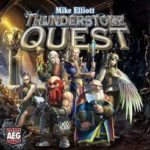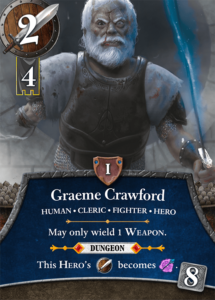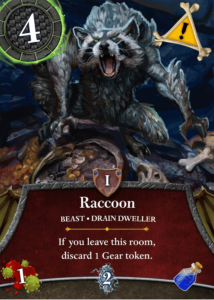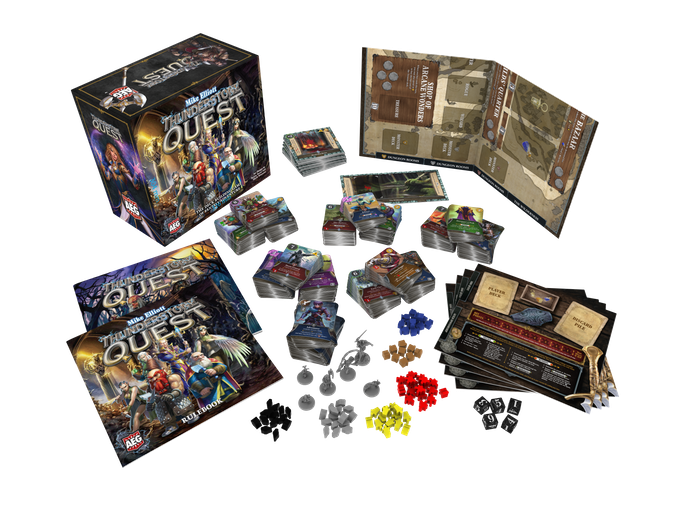Thunderstone Quest (Boardgame)
 The fantasy-themed deckbuilder, Thunderstone, has reappeared with some minor improvements and the option of (mildly) story-based campaign play in the form of Thunderstone Quest. Initially launched as a Kickstarter, a second Kickstarter has just begun with previous and new offerings. As with other deckbuilders, Thunderstone has players purchase cards from a central tableau to improve their starting deck of cards, but it also introduces an area for players to use their cards to defeat monsters for additional points. Thunderstone Quest is the third version of the game, polishing up a few rough edges and introducing a story-based campaign mode to link a series of games together.
The fantasy-themed deckbuilder, Thunderstone, has reappeared with some minor improvements and the option of (mildly) story-based campaign play in the form of Thunderstone Quest. Initially launched as a Kickstarter, a second Kickstarter has just begun with previous and new offerings. As with other deckbuilders, Thunderstone has players purchase cards from a central tableau to improve their starting deck of cards, but it also introduces an area for players to use their cards to defeat monsters for additional points. Thunderstone Quest is the third version of the game, polishing up a few rough edges and introducing a story-based campaign mode to link a series of games together.
Thunderstone Quest
Designer: Mike Elliott, Bryan Reese, Mark Wootton
Publisher: Alderac Entertainment Group
Players: 2-4
Ages: 14+
Time: 60-90 minutes
(review copy provided by publisher)
A player’s turn in Thunderstone uses one of two key elements: the marketplace (where players buy new cards) and the dungeon (where players use their cards to fight monsters.) Players choose which area to visit at the start of their turn (presumably based on what cards they have in their hand.) In the market, players use the gold totals on their cards to buy new item and spell cards which will increase their combat abilities or their gold income, or both. In the dungeon section of the board is a list of different dungeon rooms occupied by monsters. Players enter the dungeon area and can then move their character token around in the dungeon using the value of “light” shown on their cards. More light means a player can move deeper into the dungeon and fight bigger (and more valuable) monsters. Defeat monsters to earn points, treasure, and experience points.
The experience points are worth points at the end of the game, but in the early game it is more valuable to spend them in order to improve one’s deck with better hero cards. These cards are purchased in the market. Players choosing to attend the market use the gold displayed on their cards to purchase a new card. This card is placed in the player’s discard, to be shuffled into their deck at a later date. Other actions can be performed here, but the most important one is the ability to upgrade a hero card.


Hero cards are the primary way to defeat monsters in dungeons. Every game has four types of heroes, each with their own strengths and weaknesses. Heroes provide offense in the dungeon and can use weapon cards to increase their attack. (Weapons are useless without a hero card to wield them.) The experience points from defeated monsters can be used to upgrade a hero card to its next level. Players begin with 0-level Adventurers in their deck, which are generic, rather weak, heroes. However, they can be upgraded to become a level 1 hero of any of the four available hero types that game. Heroes can be upgraded to a maximum level of 3. Level 3 heroes typically have very strong abilities that can often chain together with the right equipment or other type of card.
Once a player feels like they have a strong hand of offensive cards, they can choose to enter the dungeon to fight. Players first place their pawn on the top (wilderness) location. Players can fight the monsters there, or use the Light value on their cards to move deeper into the dungeon. Monsters are placed in a grid two wide and three deep. Deeper levels require more light to move through but also contain more powerful monsters with greater rewards. The monster locations may also affect gameplay – changing aspects of combat or restricting a player’s movement within the dungeon. Defeating monsters will typically a players’s primary source of points within the game. Defeated monsters are replaced with cards from the appropriate deck. Within the monster decks are Thunderstone cards. When enough Thunderstone cards are revealed, the game’s overarching villain appears and each player has one turn to try to defeat them for extra points. Once that round is over, players total up their points on purchased (and some hero) cards, defeated monsters, and any extra experience points to determine the game winner.

In addition to a standard game of Thunderstone, the big concept for Thunderstone Quest is the option of playing through a thematically linked series of “adventures” (games) described in the Quest book. Each game is set up with some flavor text describing the situation and a specified setup for which monsters, items, and heroes will be used for that game. While a “standard” game of Thunderstone would typically randomize the available cards (with some guidelines to keep things balanced) a quest scenario does a nice job of fitting heroes, items, and monsters into a somewhat coherent theme. They have a nice progression of difficulties going from straightforward cards to more complex combinations in later games.
The Quest in Thunderstone Quest can be a bit of a misnomer. Each game in a quest introduces new cards and carries along the flavor text storyline, but they aren’t specifically linked (unless you want to keep track of players’ point totals over several games.) This is very nice, but if people are hoping results in one game carry over to a later one, they will be disappointed. However, the rulebook does provide a way to play a Campaign Mode. Players play a series of games and add their scores to their previous totals. At the end of each game, players are allowed to keep one Marketplace card from their deck to use in all subsequent games. Thus, the second game players have an extra card, the third game they’ll start with two extra, etc.. The rules mention you may want to ramp up the difficulty of the monsters a bit (suggestions are given) for later games if you play a longer series of games. I like the idea, but have a small concern that it might mean the rich get richer – players may not choose the same card to keep as their opponents and the winner of the game picks first. Despite this, I wish it would have also been part of the questing series, but one can’t have everything.
Verdict:
Thunderstone Quest takes the best of the previous two versions and creates a nice coherent system of play that is able to support a (very) wide range of options. The use of light has been reworked, and the way monsters appear and are located in the dungeon has been overhauled. These changes greatly reduce the common situation in the past where the dungeon was full of either unbeatable or simply far too weak monsters to be worth defeating. The new version also includes one-use tokens which can be picked up at the marketplace for spare change. These are nice because they prevent particularly bad draws where you find yourself with “extra” gold and can help mitigate poor draws later by providing additional help. Thunderstone Quest probably won’t win over anyone who disliked the original, but its improvements and campaign mode should be very attractive to new and old fans. Fans of deckbuilders in general should at least take a look.

The Kickstarter “Champion Edition” (reviewed here) is a beast of a box, containing more than 1300 cards (plus additional bits), most of which comprise the cards for each of the five quest series (about 250 cards per quest.) A more affordable mass-market release will still have around 700 cards (including two questlines.) Starting July 17th, a second Kickstarter campaign entitled Back to the Dungeon provides gamers with a way of obtaining the Champion edition with the original Kickstarter goodies and introduces a new expansion entitled “To the Barricades!” which introduces solo and co-op play options (which I consider to be very exciting – although there supposedly be solo & co-op rules available online at some point.) Alas, as with all things Kickstarter, the new expansion won’t be available until early next year.
Kid Factor
Lots of reading, so reading is a must, but then strategy and card combinations also require a bit of strategy and understanding. I’d say the game is fine for a tween (10-12) but may be a bit much for a younger set. The themes are not extremely dark, but have the standard fantasy tropes such as ugly/demon-y/squishy things. This is true for the art as well. There is the occasional underclad female (or male) but that is not the norm (and, thankfully, it’s a simple matter of less than optimal clothing and not suggestive poses or the like.)





Discussion Area - Leave a Comment